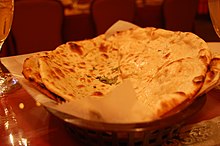Paratha

A Paratha ( Panjabi : ਪਰੌਂਠਾ, Hindi : पराठा, Urdu : پراٹھا, Bengali : পরোটা) is an unleavened flatbread , which originated in the Indian subcontinent. "Paratha" is a combination of the words ready (Hindi: परत, Bengali: পরত, Urdu: پرت) and atta (Hindi: आटा, Panjabi: ਆਟਾ, Bengali: আটা, Urdu: آٹا) and means layers of baked goods according to the literal translation Dough . In Burma it is known under the name palata , in the Maldives it is known as farata . The Paratha is related to the Parotta in South Indian cuisine .
In general, there are many different types of paratha. One can roughly separate the unfilled, simple Paratha from the filled. The latter are then divided into the round roti- like, homogeneous flatbreads and the angular paratha, whose layered shell encloses a filling that can consist of a wide variety of ingredients. Paratha are served with butter , chutney , Indian pickles , yogurt or with curries . Sometimes they are served unfilled with tea , where they are formed into a roll and dipped into the tea.
preparation
The dough usually consists of atta or highly refined maida (a wheat flour), ghee or oil and is often filled, for example with potatoes, cauliflower or panir . Either the filling is kneaded with the dough or the dough is wrapped around the filling like an envelope. Paratha, like roti, are baked on both sides in a flat pan or on a convex or flat tray.
Some examples of common variations:
- Kima Paratha ( Punjab and Hyderabad ; with minced meat)
- Gobhi Paratha (with cauliflower)
- Alu Paratha (with potato)
- Tamata Paratha (with tomato)
- Chana Paratha (with chickpeas)
- Panir Paratha (with cheese)
- Dal Paratha (Northwest and West Indies; with legumes)
- Sattu Paratha ( Bihar and Uttar Pradesh ; with toasted lentil flour)
- Tanduri Paratha (from the clay oven)
- Anda Paratha (with egg)
- Podina Paratha (with mint)
- Mughlai Paratha (with egg and minced meat)
- Mattar Paratha (with peas)
- Palak Paratha (with spinach)
- Mitha or Sugar Paratha (dessert)
- Kerala and Ceylon Paratha (see Parotta )
History and popularity
The paratha is an important part of the North Indian breakfast . Originally from this part of the country, it spread to different parts of the Indian subcontinent. It is traditionally made with ghee, but due to health issues, some people also prepare it with oil or in the oven. It is consumed with chai and raita as part of breakfast , but it is often also eaten filled with potatoes, panir, onions or keema . The South Indian version of this flatbread is called porotta .
Through Indian immigrants , this dish also spread to other countries such as Malaysia , Mauritius (where it is known as farata ) and Singapore . In Burma , where it is known under the name palata , it is eaten with curries, eggs or mutton and also as a dessert with sugar . Htat ta ya , translated "a hundred layers", is a deep-fried, multilayered paratha that is served with either sugar or boiled beans ( pè byouk ).
The process of making a Paratha is quite complex due to the layering. Nevertheless, it is also becoming more and more popular in countries in the western world, which is why there is now a selection of frozen ready-made Paratha.



